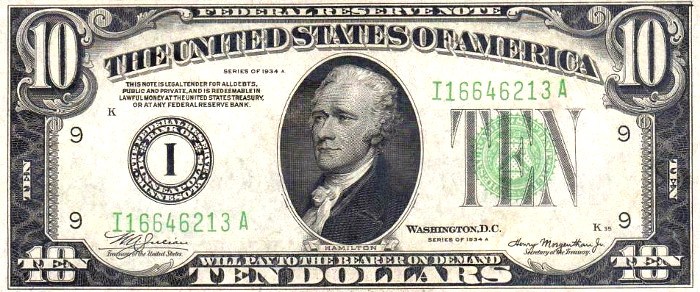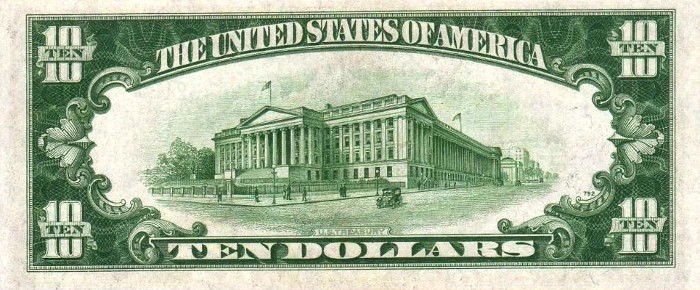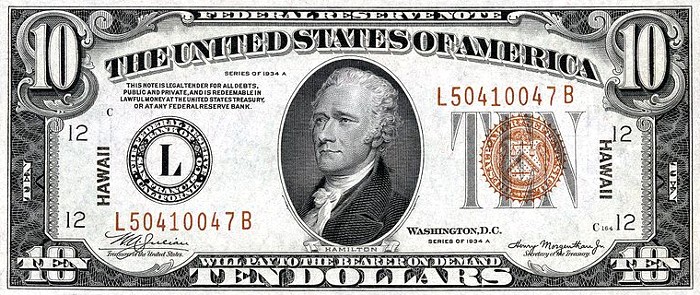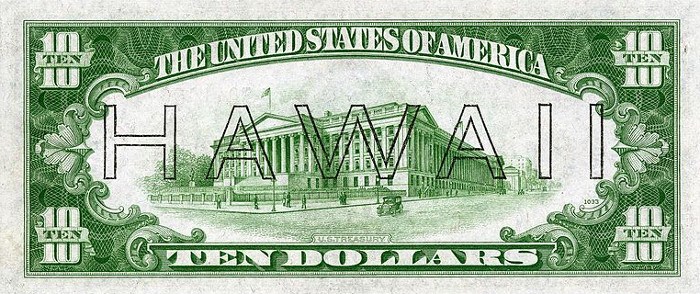The 1934 10 dollar bill is a Federal Reserve note with a green seal. It's different than the 1934 10 dollar silver certificate which has a blue seal. This Federal Reserve note is common, but if you have a star variety or a Hawaii overprint note then it could be valuable. Keep reading to learn more about this bill and the different series.


Specifications
| Denomination: | $10.00 USD |
| Series: | Five: 1934, 1934A, 1934B, 1934C, and 1934D |
| Portrait: | Alexander Hamilton |
Value
Because the standard bills are very common, they aren't worth much money. Most bills in circulated condition will only sell for their face value of $10. Bills that are in very fine condition and up can sell for a premium. Star notes will also sell for a premium.
The 1934 series $10 bills have two different seal varieties. There are the light green seals (LGS) and the darker blue-green seals. The LGS are generally worth more money.
The 1934 series $10 bills with the light green seals are worth around $20-35 in very fine condition. In uncirculated condition the price is around $100-150 for bills with an MS 63 grade.
The 1934 series $10 bills with the darker blue-green seals are worth around $15-23 in very fine condition. In uncirculated condition the price is around $55-85 for bills with an MS 63 grade.
The 1934A series $10 bills are worth around $12-17.50 in very fine condition. In uncirculated condition the price is around $40-60 for bills with an MS 63 grade.
The 1934B series $10 bills are worth around $15-20 in very fine condition. In uncirculated condition the price is around $60-85 for bills with an MS 63 grade. Bills issued from the Federal Reserve Banks of Boston and Cleveland will be worth more.
The 1934C series $10 bills are worth around $15 in very fine condition. In uncirculated condition the price is around $40-65 for bills with an MS 63 grade.
Lastly the 1934D series $10 bills are worth around $15-20 in very fine condition. In uncirculated condition the price is around $50-70 for bills with an MS 63 grade.
Bills with low serial numbers are more valuable. You can tell if you have a low serial number if the number starts with six or seven zeros. These low serial number bills command a premium. Even bills starting with five zeros can command a small premium.
Note: Valuable bills should be placed inside currency holders.
Star Notes
There are star note variaties that are more rare and thus worth more money. Star notes are overprint notes that have a star symbol at the end of the serial number.
The 1934 series $10 star notes with the light green seals (LGS) are worth around $125-150 in very fine condition. In uncirculated condition the price is around $950-1,250 for bills with an MS 63 grade.
The 1934 series $10 star notes with the darker blue-green seals are worth around $70-115 in very fine condition. In uncirculated condition the price ranges from $400-900 for bills with an MS 63 grade. The exact price in uncirculated condition will depend on the issuing bank.
Most 1934A series $10 star notes are worth around $40-65 in very fine condition. In uncirculated condition the price is around $225-250 for bills with an MS 63 grade. Notes issued from the Federal Reserve Bank of Boston will be worth less money. Notes issued from the Federal Reserve Bank of Minneapolis will be worth more money.
The 1934B series $10 star notes are worth around $75-90 in very fine condition. In uncirculated condition the price ranges from $400-950 for bills with an MS 63 grade. The exact price in uncirculated condition will depend on the issuing bank.
The 1934C series $10 star notes are worth around $55-67.50 in very fine condition. In uncirculated condition the price ranges from $250-750 for bills with an MS 63 grade. The exact price in uncirculated condition will depend on the issuing bank.
Lastly most 1934D series $10 star notes are worth around $55-65 in very fine condition. In uncirculated condition the price is around $400-550 for bills with an MS 63 grade. Notes issued from the Federal Reserve Banks of Richmond, St. Louis, Minneapolis, Kansas City, Dallas, and San Francisco will be worth more money.
Hawaii Notes


During WWII the US government issued the 1934A series $10 Hawaii notes. Hawaii notes look much different than the standard 1934 notes- they have brown seals and a Hawaii label. The government issued this note as a precaution in case Japan took over Hawaii. These notes would instantly become worthless if Japan gained control of Hawaii's money supply.
The 1934A $10 Hawaii notes are worth around $125 in very fine condition. In uncirculated condition the price is around $750 for notes with an MS 63 grade.
The 1934A $10 Hawaii star notes are worth around $700 in very fine condition. In uncirculated condition the price is around $11,500 for notes with an MS 63 grade.
Grading System
Very fine- A note that has been in circulation but not for a long time. The note is still relatively crisp. There may be some creases, folds, or light smudges.
MS 63 choice uncirculated- A note that shows no signs of ever having been in circulation. The note still has its original crispness. The note is also well-centered.
Conclusion
The common issue variety 1934 ten dollar bills aren't going be worth much money. However the star notes and the Hawaii notes can be worth hundreds of dollars.
Sources:
A Guide Book of United States Paper Money
See also:
